
Cast * Interesting Facts * Behind the Scenes * Hercules: the TV Series


Directed and Written by: John Musker & Ron Clements
Music by: Alan Menken & Alan Zippel
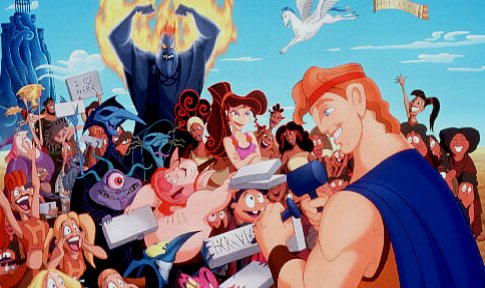 Released
on: June 27, 1997
Released
on: June 27, 1997
Running Time: 93 minutes
Budget: $70 million
U.S. Opening Weekend: $21.454 million over 2,872 screens
Box-Office: $99 million in the U.S., $250.6 million worldwide
 |
 |
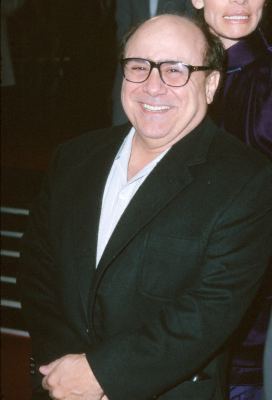 |
 |
 |
Hercules...
Tate Donovan
Philoctetes... Danny DeVito
Megara... Susan Egan
 Hades,
Lord of the Underworld... James Woods
Hades,
Lord of the Underworld... James Woods
Hermes, the Messenger God... Paul Shaffer
One of the Fates... Amanda Plummer
Nessus, the River Centaur... Jim
Cummings
Susan Egan (b. 1970) is a famous Broadway star
-she created the role of Belle in the Beauty
and the Beast's
musical
musical and also starred in classics such as Cabaret. She
returned, along most of the film's cast, in the TV series
adapted from Hercules.

![]() When young Hercules
pulls the cart through the town's arch at the entrance, he almost knocks
down two construction workers to the ground. These workers are animated
versions of directors John Musker and Ron Clements, who also did their
own voices, too!
When young Hercules
pulls the cart through the town's arch at the entrance, he almost knocks
down two construction workers to the ground. These workers are animated
versions of directors John Musker and Ron Clements, who also did their
own voices, too!
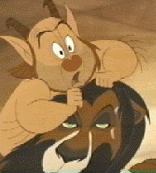
![]() When Phil is hit by a discarded painter's palette he cleans himself up
using a lion's fur that bear a striking resemblance to Scar from The
Lion King.
When Phil is hit by a discarded painter's palette he cleans himself up
using a lion's fur that bear a striking resemblance to Scar from The
Lion King.
![]() During the number
where Meg sings, the muses are singing background music as statue heads.
If you pay attention as the camera pans, the heads (or statues) are exactly
the same as the Haunted Mansion singing heads. Even with one of them broken
as in mansion!
During the number
where Meg sings, the muses are singing background music as statue heads.
If you pay attention as the camera pans, the heads (or statues) are exactly
the same as the Haunted Mansion singing heads. Even with one of them broken
as in mansion!

![]() There are 9 muses in Greek Mithology, but only 5 are shown in the movie:
Thalia the muse of Comedy (the Fat one), Clio the Muse of History (Long
Hair), Melpomene the muse of Drama (Shot Hair), Calliope the muse of Eloquence
(Tall One) and Terpsichore the muse of the Dance (Curly Hair).
There are 9 muses in Greek Mithology, but only 5 are shown in the movie:
Thalia the muse of Comedy (the Fat one), Clio the Muse of History (Long
Hair), Melpomene the muse of Drama (Shot Hair), Calliope the muse of Eloquence
(Tall One) and Terpsichore the muse of the Dance (Curly Hair).
![]() From the 12 labours
of Hercules these are the ones that made into the film: the Killing of
the Hydra, the killing (actually kicking) of the Lion of Nemea, the Boar,
the capture of the deadly birds of the Estanfalo Lake, go down to the underworld
and beat the three headed dog Cerebus, the cleaning of the king's stables
and getting the amazon's girdle.
From the 12 labours
of Hercules these are the ones that made into the film: the Killing of
the Hydra, the killing (actually kicking) of the Lion of Nemea, the Boar,
the capture of the deadly birds of the Estanfalo Lake, go down to the underworld
and beat the three headed dog Cerebus, the cleaning of the king's stables
and getting the amazon's girdle.
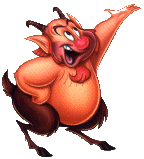
![]() Hades was scripted as a slow, menacing character until James Woods auditioned
for the role and impressed the casting directors with his rapid-fire style.
The script was rewritten, but Woods ad-libbed many lines.
Hades was scripted as a slow, menacing character until James Woods auditioned
for the role and impressed the casting directors with his rapid-fire style.
The script was rewritten, but Woods ad-libbed many lines.
![]() Phil's line "Don't
let your guard down because of a pair of big goo-goo eyes" was originally
"Don't let your guard down because of a pair of big, blue eyes." Unfortunately,
by the time the scene was in color, Meg's eyes were purple.
Phil's line "Don't
let your guard down because of a pair of big goo-goo eyes" was originally
"Don't let your guard down because of a pair of big, blue eyes." Unfortunately,
by the time the scene was in color, Meg's eyes were purple.
![]() A source close
to Walt Disney Studio revealed in October 2001 that Ron Clements and John
Musker, who directed the original 1997 Hercules,
are interested in making a sequel. A first script for the film has just
been turned in: it follows the adventures of Hercules, who is now living
in Athens with Megara and their daughter, Hebe. When an old friend named
Helen is captured by the evil Paris of Troy, Hercules joins the united
Greek army as they head out to war. However this war will create revelations,
including Hercules finding an old friend that went missing... There would
be several new characters for the film, including a new design for Philoctetes,
who would return.
A source close
to Walt Disney Studio revealed in October 2001 that Ron Clements and John
Musker, who directed the original 1997 Hercules,
are interested in making a sequel. A first script for the film has just
been turned in: it follows the adventures of Hercules, who is now living
in Athens with Megara and their daughter, Hebe. When an old friend named
Helen is captured by the evil Paris of Troy, Hercules joins the united
Greek army as they head out to war. However this war will create revelations,
including Hercules finding an old friend that went missing... There would
be several new characters for the film, including a new design for Philoctetes,
who would return.
 |
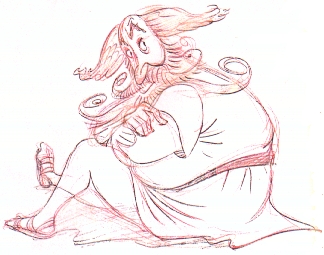 |
The following article, "Who the hell do we get to play Hades?", was written by Jim Hill and published at The Laughing Place in April 2001.
"After putting together two massive money-makers for the Mouse, you'd think that Walt Disney Studios would be feeling pretty grateful toward animation maestros Ron Clements and John Musker, right?
After all, these were the guys who'd delivered the 1988 cartoon hit, The Little Mermaid as well as the 1992 blockbuster, Aladdin. It just made sense that the company would try to show its appreciation toward Ron & John - by maybe allowing them to finally make their dream project - a comic book style space-based update of Robert Lewis Stevenson's pirate adventure, Treasure Island.
Not necessarily.
What was the problem? Then Disney Studio head Jeffrey Katzenberg just didn't see the appeal of Treasure Planet. Space-faring pirates zooming around the universe in big 1950s-style finned rocketships? What audience was this proposed animated film aiming for, anyway? Teenage boys who like old comic books? That audience segment just seemed too small to Katzenberg to count on to turn the film into another animated blockbuster.
What did Jeffrey want? He wanted Musker and Clements to come through with yet another mega-hit for the studio. Another film that would deliver $100 million+ at the box office, plus millions more in merchandise sales. Not some silly little sci-fi spoof that would only appeal to comic book fans.
Jeffrey left Ron and John alone to develop Treasure Planet 'til the Fall of 1993. Then - after officially hearing their pitch for the project - Katzenberg told Musker and Clements that there was no way that he could ever see himself greenlighting this proposed animated film ...
Unless ...
Knowing how desperately Ron & John wanted to make Treasure Planet, Katzenberg proposed a deal: He would allow Musker and Clements to produce their sci-fi spoof, but only after they had delivered an earlier animated project for the studio with a much broader audience appeal. (You parents out there reading this might might recognize this maneuver, It's the old "No dessert until you finish your vegetables" ploy. )
Needless to say, after working on Treasure Planet for almost a year, Ron & John were plenty upset that Jeffrey wasn't allowing them to get right to work on their dream project. They recognized that their space pirate story might initially appear to appeal to only a small segment of the potential movie-going audience. But Musker and Clements also argued that - given their track record with Little Mermaid and Aladdin (Where they had taken problematic story material but still delivered movies that had huge appeal to mass audiences) - that they earned the right to try something different.
Katzenberg wouldn't hear of it. He made it clear that this was an "either / or" proposition. Either Ron & John settled for producing a more commercial animated project before getting a shot at making their sci-fi spoof OR Katzenberg promised that - as long as he was head of the studio - Treasure Planet was never going to get made.
Musker and Clements weren't particularly thrilled with this proposition. But they understood that if they agreed to Jeffrey's proposed deal they still might someday get the chance to make their comic book movie. So Ron & John reluctantly put aside their work on Treasure Planet. They then turned to the folks in Disney Feature Animation's development office and asked: "What have you got in the pipeline?"
Plenty of stuff, as it turned out. Among the 30 different story ideas Disney then had in development as potential animated films were adaptations of Jules Verne's Around the World in 80 Days as well as Cervantes' Don Quixote. There were also proposals for cartoons based on such legendary tales as Pygmalion and The Odyssey.
Musker and Clements looked over the concept material for these proposed Disney animated films and found most of them lacking. According to Ron and John, a lot of the story ideas lacked comic potential or just didn't lend themselves to the animation format. They had almost given up hope until they came across animator Joe Haidar's pitch for a Hercules feature.
Here - possibly - was something Musker and Clements could work with. Hercules was arguably the world's first super hero. Hundreds of tales had been told of his great adventures, where Herc had battled numerous monsters and/or beaten impossible odds.
But what particularly intrigued Ron and John was how - way back then - Herc's heroics had been merchandised. As a tribute to these oft-told tales, Hercules' likeness had been slapped on thousands of dishes and vases in this period. Just as Disney does today while marketing its animated films.
Latching on to this factoid (as well as remembering Katzenberg's insistence that their next film be extremely commercial), Ron and John came up with a subversive subtext for their next project: Why not use the legend of Hercules as the basis for a free-wheeling satire on modern American society?
Musker and Clements were almost gleeful from this premise's comic possibility. They could rearrange Hercules' exploits so that they pointedly commented on our nation's obsession with sports heroes and celebrities. They could also take a few well aimed pokes at a certain Mouse-based company for being so obsessed with moving merchandise. The potential for satire seemed endless.
So that's how Ron and John decided that Hercules would be their next animated project for Disney Studios. Katzenberg was thrilled when he heard their choice. He thought that - since so many people worldwide already knew Hercules' name - this would make this Disney animated feature that much easier to promote. Jeffrey felt that the film was a hit even before its first scene was animated.
But right from the start Hercules proved to be a tough project for the
Mouse. Disney had never done a feature length satirical cartoon before,
particularly one that had to appeal to children as well as grown-ups. So,
for every racy in-joke they aimed at adults, Ron & John made sure that
there were an equal number of kid-friendly gags to be found in the film.
It took months to get the story's balance just right.
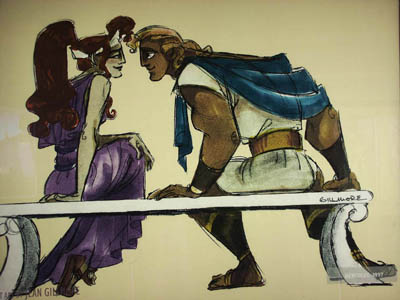
Then there was the casting of the film. Since Musker and Clements wanted
their Hercules to satirize celebrity, it was crucial that as many of the
film's characters as possible be voiced by big name entertainers. Disney's
casting office really out-did themselves on this project; snagging Charlton
Heston, Danny DeVito, Rip Torn, Bobcat Goldthwait, Matt Frewer, Paul Shaffer,
to name just a few.
But one role eluded them: Hades, Lord of the Underworld.
Who would be cool enough, funny enough, but menacing enough to deliver the goods on this character?
There was really only one obvious choice. But he was so out of Disney's league, so beyond doing something as piddley-squat as a cartoon, that no one on the Hercules production team even dared to mention his name.
It was only after Danny DeVito was on board the project that his name finally came up. One day, Danny asked who Ron and John had in mind to play Hades. Musker and Clements mumbled under their breath a bit, saying they hadn't yet come up with the right performer for the job.
DeVito just blurted it out. "Why don't you ask Jack?"
That's right. Jack. As in Jack Nicholson.
Wouldn't Nicholson have made the perfect Hades? The folks at Disney sure thought so. They even had a concept painting put together of Jack playing the role. If you have a copy of Stephen Rebello and Jane Healey's wonderful making-of book for this film (The Art of Hercules: The Chaos of Creation. 1997. Hyperion Press), you can actually see that very same painting on Page 98. That's Nicholson - wearing his ever-present sunglasses - as Hades, seated on his throne in Hell.
But the folks at the Mouse were so in awe of Nicholson's reputation that they hadn't even dared to approach him about the Hercules project. It was actually DeVito (who had directed as well as co-starred with Jack in 20th Century Fox's 1992 release, Hoffa) who made the call to Nicholson, asking if he'd be interested in doing a voice for an animated film for Disney.
Would he be? Sure!
The very next week, Nicholson drove up to the Burbank lot. He brought along his daughter, Lorraine, who came dressed as Snow White. (When folks at the Mouse saw how Jack's little girl was dressed, they took it as a very good sign.) Musker and Clements. along with several other top end Disney executives. gave Jack and his daughter a full tour of the lot. They then took the two of them to lunch at the executive dining room in the Team Disney Building.
After lunch, everyone wandered over to Feature Animation where Ron and John made their pitch. They told Nicholson and his daughter the story of Disney's Hercules, emphasizing Hades' central role in the proceedings. Jack was charmed by what he saw and seemed genuinely enthusiastic about taking part in the project.
There was just one slight minor snag.
Money.
Putting it simply, Nicholson wanted an obscene amount of money to play Hades. Disney was hoping to sign him for the part for $500,000, maybe as much as $1 million. Nicholson wanted something more along the lines of $10 - $15 million, plus a 50% cut of all the proceeds from Hades merchandise.
This may seem like an outrageous amount to ask for. But - to Jack's way of thinking - it wasn't unprecedented. He had asked for - and received - a similar deal from Warner Brothers way back in 1986, when he played the Joker in Tim Burton's Batman. Since that film had grossed over $400 million, Warners had more than gotten its investment back in Jack. Plus Nicholson had made an absolute fortune off his share of the Joker merchandise. Some estimate that Jack's cut of the Batman merchandising bonanza eventually came to $50 million.
Nicholson knew that his star power would add considerably to Hercules box office potential. All that Jack asked was that he adequately compensated for his efforts.
It was a heart-breaking moment for Musker and Clements. They knew that Nicholson really wanted to be in Hercules. They also knew that having Jack as the voice of Hades would do for this film what landing Robin Williams to play the Genie did for Aladdin. That 1992 Disney film went on to gross $217 million domestically - most of that just because people came out to see Williams in cartoon form. Audiences were sure to do the same for Jack which meant that Hercules' domestic box office potential was almost unimaginable.
But Ron and John also knew that there was no way that Michael Eisner would ever okay giving Nicholson everything he had asked for. Eisner might see his way clear to giving Jack $5 million or so to play Hades. But there was no way the Mouse would share 50% of the profits from the Hades merchandise with Nicholson. That condition was the deal-breaker.
After Disney came back with a counter offer that was significantly less than what he had asked for, Nicholson passed on the project. It was hard to tell who was more disappointed: Musker and Clements, or Jack's daughter, Lorraine. After getting over their disappointment of losing Nicholson, Ron and John tried to find another Hades. They auditioned a number of actors looking for someone else who could play cool, funny and furious. Eventually, in the fall of 1994, they settled on character actor John Lithgow.
Then best known for his Academy Award-nominated performance as the trans-sexual former football player in 1981's The World According to Garp, Lithgow was obviously a talent. And he labored mightily in his recording sessions to try and make the character of Hades work.
But - as Hades' lead animator Nik Ranieri roughed out sequences using Lithgow's vocals - the scenes just laid there. There was no real humor or menace to John's version of the Lord of the Underworld. The character just came across as ... well ... a hammy actor.
After nine months of trying to make Lithgow's portrayal of Hades to work, Musker and Clements had to face facts. While John was a nice guy and a total professional to work with, he was also the wrong performer for this part. After apologizing profusely (and blaming the failure of Hades on their inadequate script, rather than on Lithgow's less-than-inspiring performance), Ron and John released John from the project in August 1995.
(One of the great ironies of this whole situation was that Lithgow was let go from Hercules because Musker, Clements and Ranieri felt that John just didn't have enough comic energy to play the part. Later that year Lithgow's new sitcom, Third Rock from the Sun, debuted on NBC. In his performance as alien-in-disguise Dick Solomon, John revealed that he has a huge gift for playing comedy. His broad farcical performances even won him two Emmys for Best Actor in a Comedy. Not enough comic energy, eh?)
With Lithgow gone, Musker and Clements are in a real tough spot. With less than 20 months 'til Hercules due in theaters, the film still doesn't have a voice for its villain. Things were looking pretty hopeless until someone suggests James Woods.
Best known for his work in edgy dramas like Joseph Waumbaugh's The Onion Field, Woods may seem like an odd choice to play a cartoon Lord of the Dead. At least, Musker and Clements thought so. But the folks over at Disney's casting office liked the speed and intelligence James demonstrated during his audition for the role. They asked Ron and John to give the guy a shot.
So that's how Musker and Clements found themselves in a recording session with James Woods, fumbling for a handle on Hades. James was looking for some sort of direction. So Ron and John explained that the Lord of the underworld was a powerful figure who was charming but ruthless, capable of doing anything he had to to get ahead.
"Sounds like some studio executives I know," Woods joked.
And that - my friends - is the real secret behind James Woods' version of Hades, Lord of the Underworld. In order to eventually earn the right to make Treasure Planet, Ron Clements and John Musker made a deal with the devil (AKA Jeffrey Katzenberg) to make Hercules first.
Now it's Halloween week 1995. And James Woods has just handed Ron & John the ultimate in-joke to slip into Hercules. After all, what better way is there for Musker and Clements to honor the man who insisted that they make this film than by placing a caricature of him into the movie?
That's right. Jeffrey Katzenberg - in all his smooth talking, schmoozy glory - served as Woods' model for his performance as Hades, Lord of the Underworld.
You want proof? Go find a picture of Disney's Hades. Then take a closer look at his long face, sharp features, intelligent eyes and balding head. Now draw a pair of glasses on the Lord of the Dead 's face.
Does this demon now look sort of familiar?
What amazes me is that this poorly kept secret didn't come out last year during Katzenberg's compensation trial. The press gave Eisner such hell for reportedly saying that he "hated the little midget," imagine the ruckus the media would have raised if they'd found out that that Michael's animators had modeled Hades' look and vocal stylings on the former Disney studio head.
The real question here is: Did Eisner know that Hades was modeled after Katzenberg?
There's no real proof that Michael knew and / or condoned this jab at Jeffrey. But I think that it's interesting to note - even though Hercules didn't do particularly well at the box office during its initial release in the summer of 1997 - Eisner still allowed Ron and John to go forward with their dream project.
That's right, Treasure Planet. Full production of the film is just now getting underway. This long-awaited sci-fi spoof should hit theaters in the summer of 2002.
So who's got the last laugh now?"
 |
 |
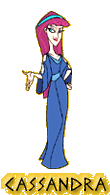 |
 |
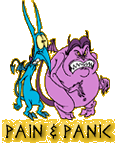 |
 |
 |
 |
![]() Little known and
short-lived, the TV series based on Hercules (1998-1999) gathered
not only the cast of the original movie -with the exception of Danny DeVito
as Phil-, but also the voice talents of many big names:
Little known and
short-lived, the TV series based on Hercules (1998-1999) gathered
not only the cast of the original movie -with the exception of Danny DeVito
as Phil-, but also the voice talents of many big names:
 Sandra
Bernhard (Roseanne) as Cassandra
Sandra
Bernhard (Roseanne) as Cassandra
|
||||||||||||